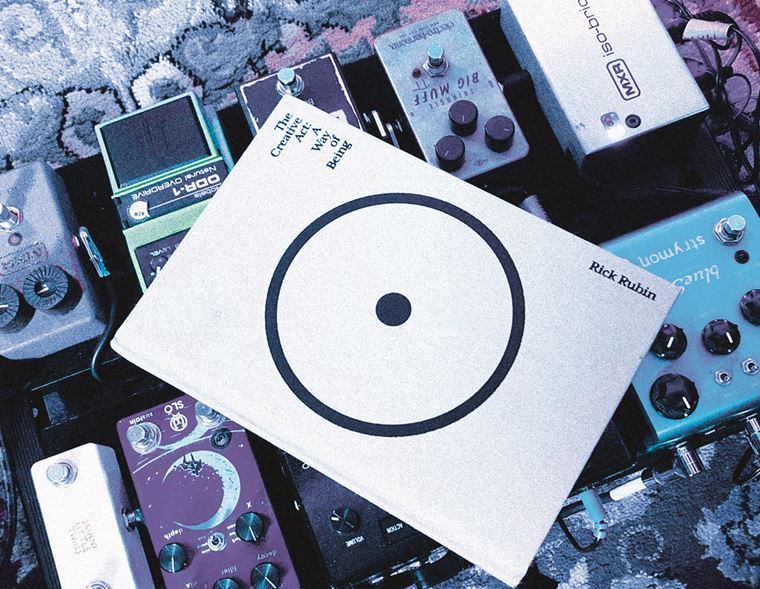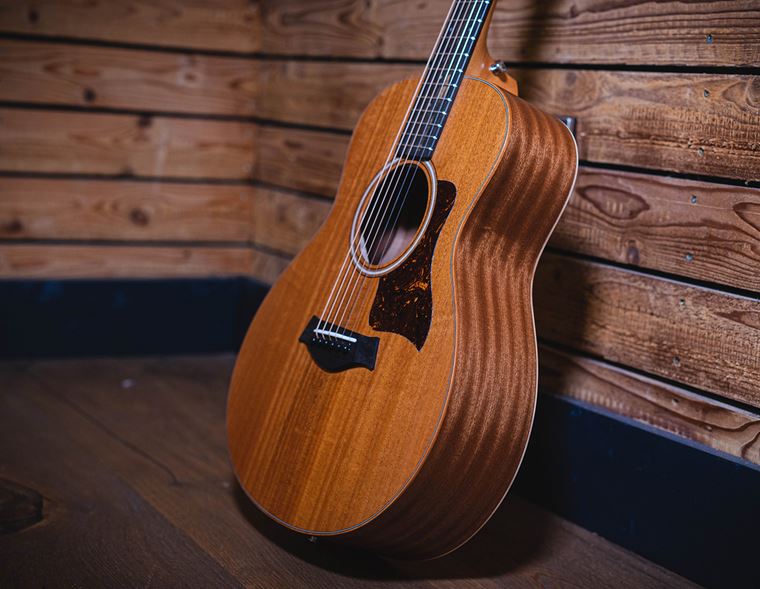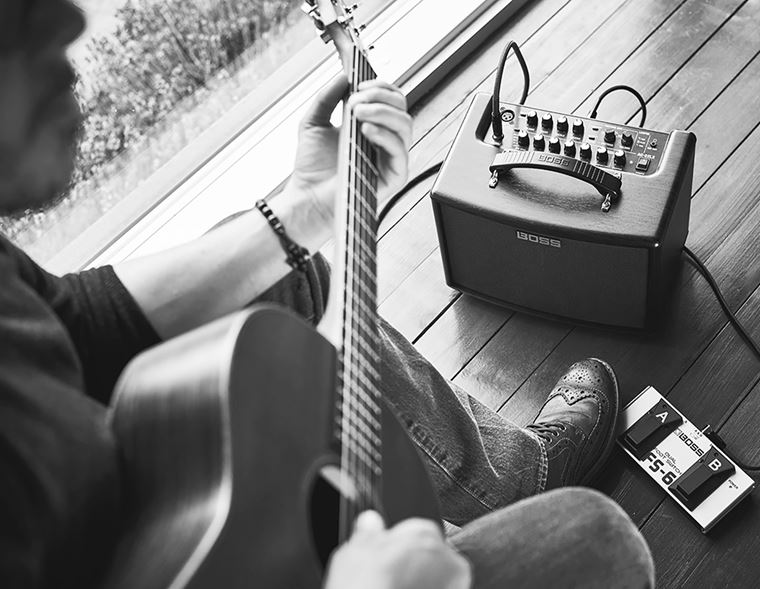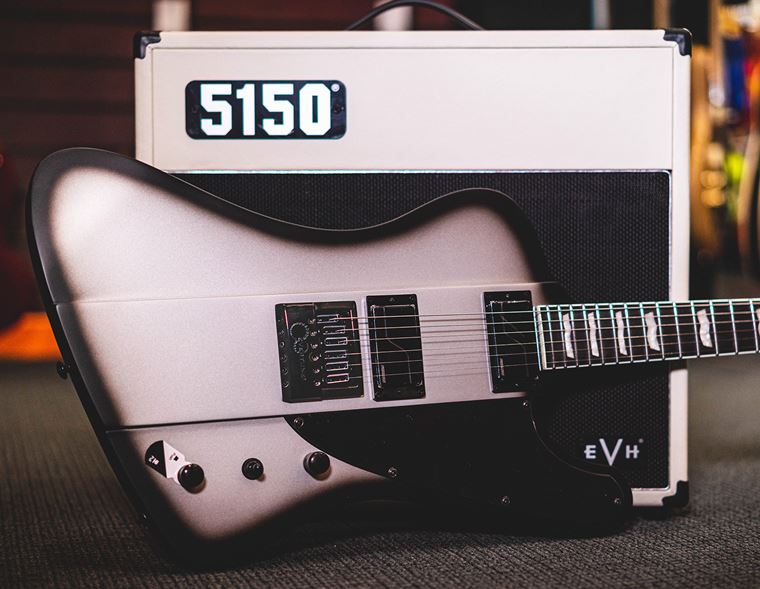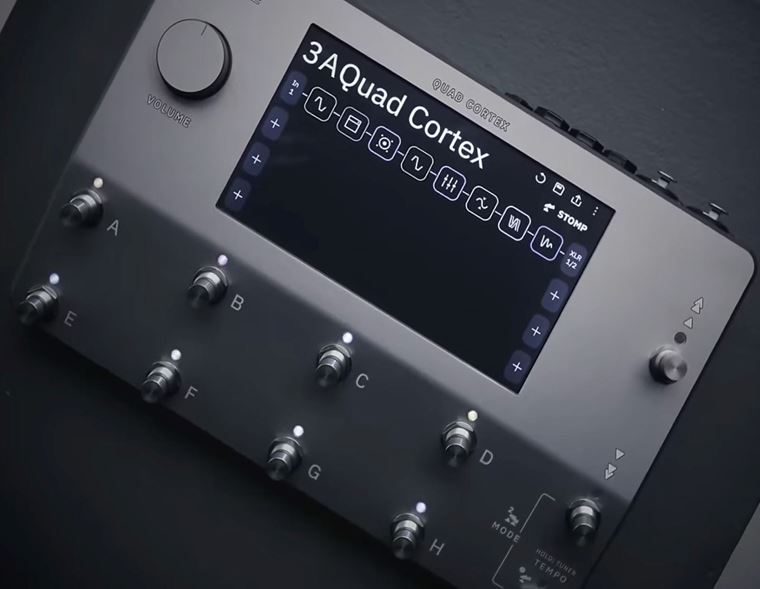Telecaster Buying Guide
Published on 19 March 2024
You’ve decided that it’s to be a Telecaster for you. Good choice! It has stood the test of time like no other electric guitar, and that’s because it’s a superbly effective instrument!
Now, even though the vast majority of Teles look exceedingly similar, you already know that that’s not the case, don’t you? How could the prices differ so widely?
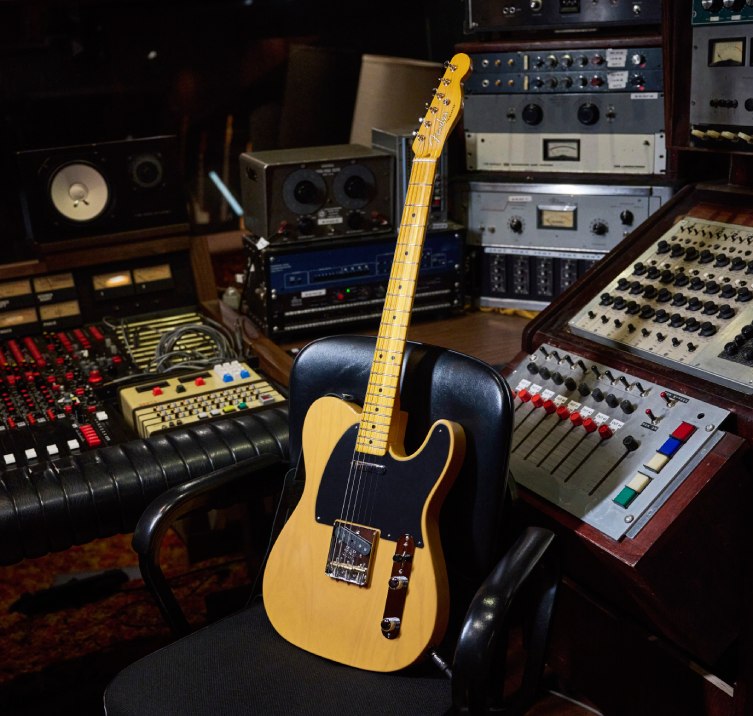
Well, today I’ll happily take you through it all, outlining the major differences that exist from series to series, and hopefully helping you decide which one is right for you.
I’m sticking with Fender, since there’s quite enough variety in their stable already, but I’ll also use some Squier examples, too. After all, they are official Fender guitars, too!
I’ll begin at the affordable end of the price brackets and head north from there. Hop aboard!
Contents
The Telecaster: Simple, Modular, Effective and Iconic
Squier Classic Vibe 50s Telecaster
Fender Vintera II 50s Nocaster and 60s Telecaster
Fender American Pro II Telecaster
Fender American Vintage II 1951 Telecaster
Fender American Ultra Telecaster
The Telecaster: Simple, Modular, Effective and Iconic
At its root, the Telecaster is a simple affair: a bolted-on neck, slab body, a pair of single coil pickups and some very straightforward controls. There’s nothing much to trip over here, but Leo Fender’s first swing of the bat proved that he knew exactly what people wanted: it exists today in a pretty much unaltered state, if you want it that way.
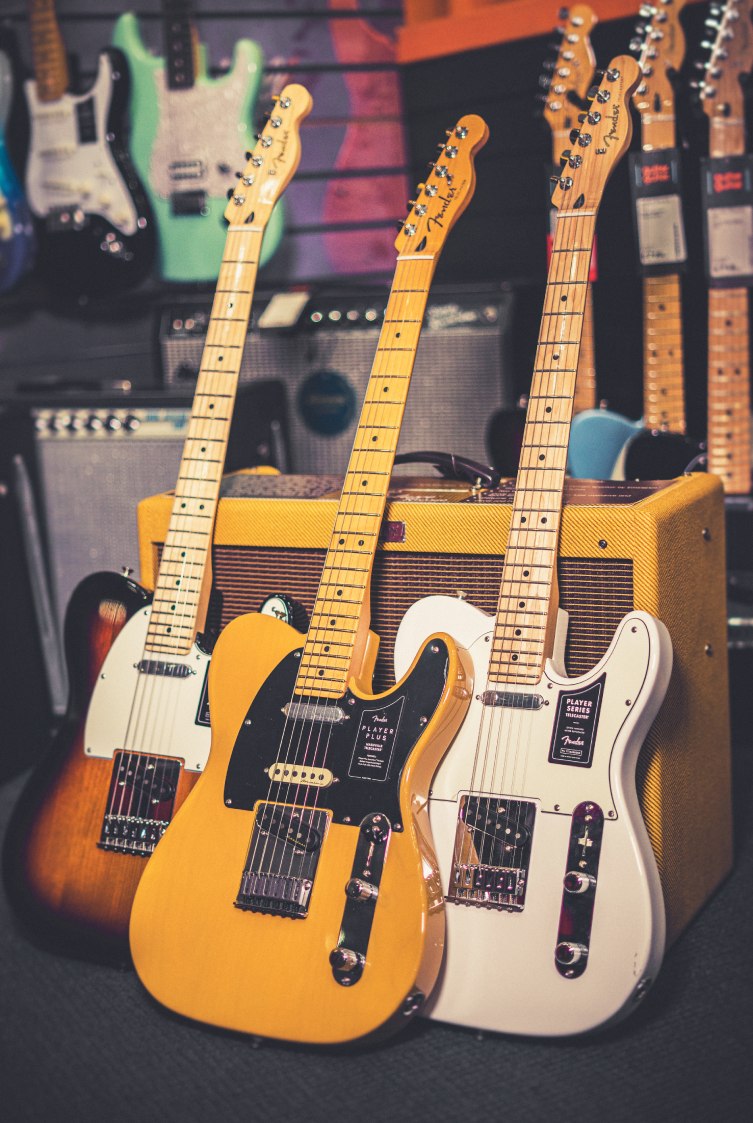
But you can also have a myriad of variations on the theme, too: humbuckers, semi-hollow bodies, even tremolos make an appearance on Teles, depending on where you look. I may turn over some of these stones as we walk our path, but I do admit that I’m interested in sticking pretty close to the blueprint with my choices. This is the easiest way for us to assess the differences, benefits and possible drawbacks to each choice and each price point. This means that, today, I won’t be looking at Tele Customs, Deluxes or any other designs that stray from that 1950s blueprint too far.
Squier Classic Vibe 50s Telecaster
So, to begin with, I’d like to summon the Squier Classic Vibe 50s Telecaster. No longer the cheapest brand on the market, Squier have actually won over some quite hard-to-please guitarists in recent years.
Squier started out as an affordable beginner/student guitar range licensed by Fender back in 1982. In recent years, however, their reputation as solid and dependable ’starter guitars’ has advanced with the introduction of the Classic Vibe series of guitars and basses. Designed with a keen eye on Fender’s historical instruments, the Classic Vibe series brought a touch of finesse and authenticity to the lower end of the market, a concept normally found on only more expensive guitars.
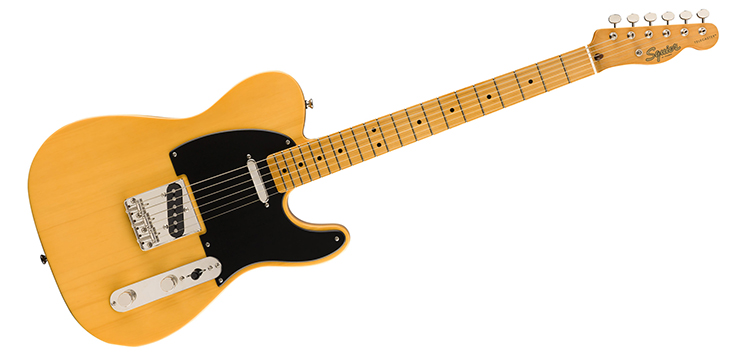
This venture by Fender/Squier has proven to be hugely popular, and that’s because the instruments have been designed and built to a very acceptable standard. This is why I’m including them in this blog: I feel like they are worth investigating for all guitarists.
There’s a good amount of choice in terms of Classic Vibe Telecasters, but I feel like the 50s model - based on the original 1952 Telecaster - is the best starting point. You can enjoy an instrument that comes with decent alnico pickups, a pine body (commendably ‘vintage correct’) and a neck that’s perhaps more playable than actual vintage examples, especially for the beginning player.
- Great vintage looks
- Good sounding pickups, particularly for the price
- A feel that will appeal to modern players
Fender Player Telecaster
Moving up from the Squier Classic Vibe, the next logical choice is the Fender Player Series. This is probably Fender’s most popular range overall, and it’s easy to understand why.
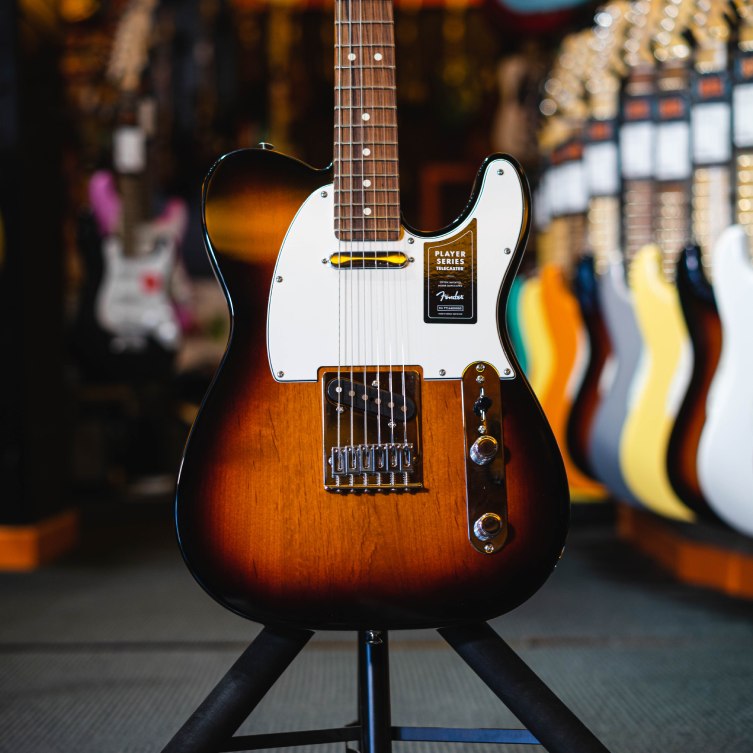
Fender Player guitars are built in Mexico (more affordable than those made in the USA) and use a good selection of player-friendly features that include the following:
- A slim (but not ‘thin’) neck that should appeal to most players
- 22 medium jumbo frets, so a nice easy feel
- Alnico pickups that sound far better than the previous ‘Mexican Standard’ range
- The proper look, good colours, very dependable
- A 6-saddle bridge, which isn’t ‘vintage’ but is actually better for setting up and intoning the guitar.
Fender have a few varieties of Telecaster in the Player series, so you can opt for a model with two humbucking pickups if you’re more of a hard rocker. I’d argue that these models sound less like typical Teles: I’d got for the original single coil model for that authentic twang. The Fender Player Telecaster is about the best ‘bang for your buck’ of any guitar on here, since you can absolutely take this guitar into any studio or onto any stage and sound great. Not bad for Fender’s ‘entry level’ Tele!
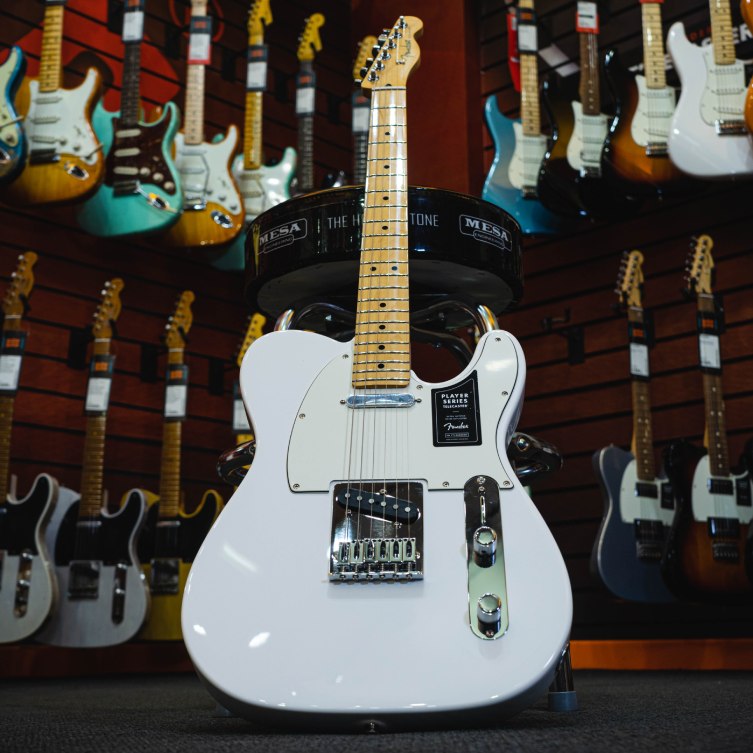
Fender Player Plus Telecaster
We just looked at the Player Tele, so what’s this Player Plus model? Simply put, it’s a modified version of that guitar, with extra features and different finishes available. I’d recommend testing one of each and seeing how these additional features measure up in your world.
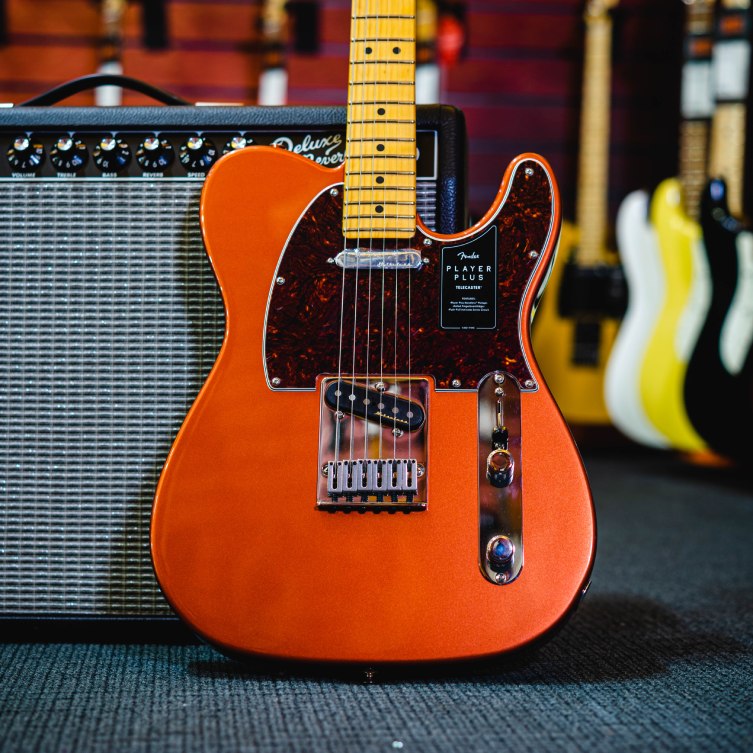
So what’s different? Let’s do a run-down…
- Noiseless pickups, so you can play as loud and as distorted as you like without incurring lots of background hum.
- 12” radius fingerboard: slightly flatter than Fender’s modern standard of 9.5”. This isn’t better, it’s just different, but if you play lots of leads and solos, you might prefer this.
- Locking tuners: restringing is quicker, and tuning stability will be greater.
- Push/pull Series control: pull up on the Tone knob and get more sounds!
- New finishes: several new colours to choose from, and some old favourites.
The Fender Player Plus Telecaster is a more modern type of Telecaster than the regular Player Series guitar, and has a very cool ‘semi-customised’ vibe. Definitely one to add to your list for closer appraisal.

Fender Vintera II 50s Nocaster and 60s Telecaster
My next choice (actually two here) goes the other way and harkens back to famous historical Teles. The Fender Vintera II 50s and 60s Telecasters are the most affordable way to own vintage-themed, retro Teles with the Fender logo on them. ‘Vintera’ is a term that has spliced the words ‘Vintage’ and ‘Era’ together, and that pretty much sums up the modus operandi of the range.
The main differences between the 50s Nocaster (so named for a short period in late 1951 when Fender couldn’t use the Tele’s original ‘Broadcaster’ name so went with no name at all!) and the 60s Telecaster are the neck profile, pickups and finish options. Firstly, though, here’s what both models have in common…
- Alder bodies: classic Fender stuff along with Ash (though some early Teles were made with Pine bodies, which only the Squier references)
- 21 fret necks with rounded 7.25” radius fingerboard for a specifically old-school feel
- Bridges with 3 saddles rather than 6: again, a more authentically ‘vintage’ thing.
- Vintage pickups (different for each model)
In terms of differences between the 50s and 60s, each model represents (in relatively loose terms) its intended place in history: the 50s Nocaster has a large ‘U’ shaped neck profile with a Maple fingerboard, and has ‘vintage 50s’ pickups, which have slightly less windings round them for a cleaner sound.
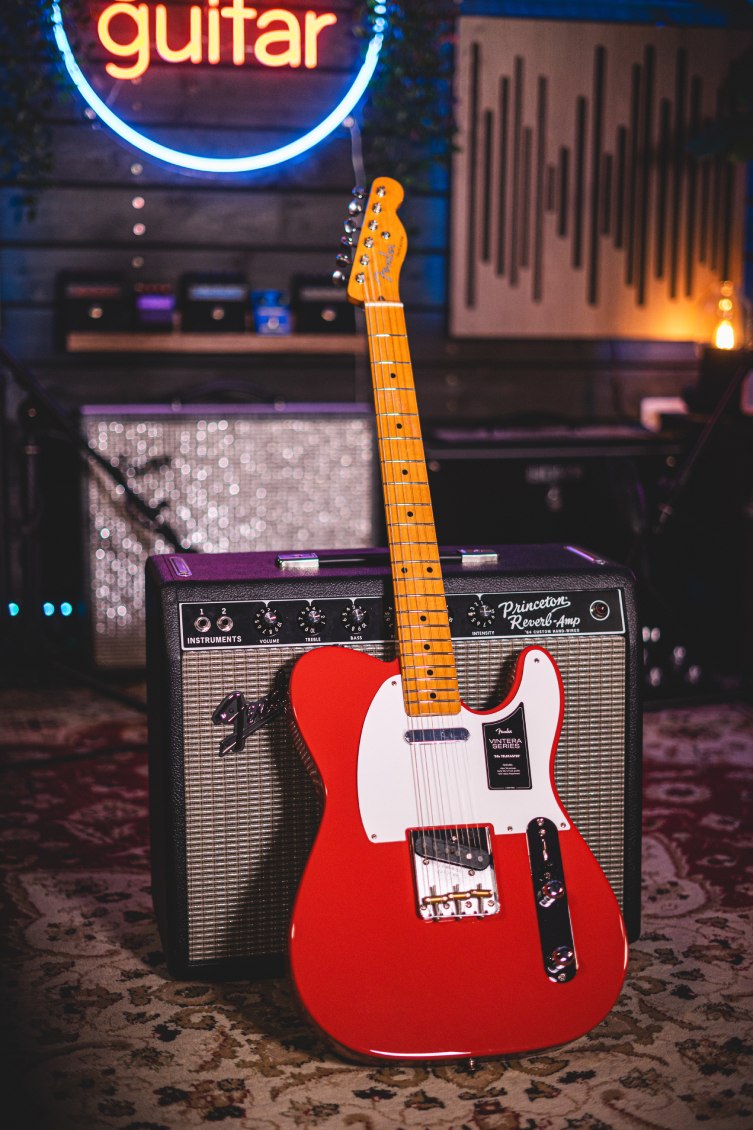
The 60s Telecaster has a rounded 60s C profile neck and a slab rosewood fingerboard. Additionally, the pickups are ‘vintage 60s’, which have a slightly hotter sound, though they are still very much a vintage tone.
Each Vintera II Tele model is a quality instrument, and the model you pick will be based entirely on how you get on with the different neck feels, and indeed the finish options!
The Vintera range is for the guitarist who favours vintage appointments. There are some who believe that a Tele isn’t a Tele if it doesn’t have a 3-saddle bridge, for example. These Vintera guitars are for those players, particularly ones who aren’t looking to spend USA prices on a new guitar.
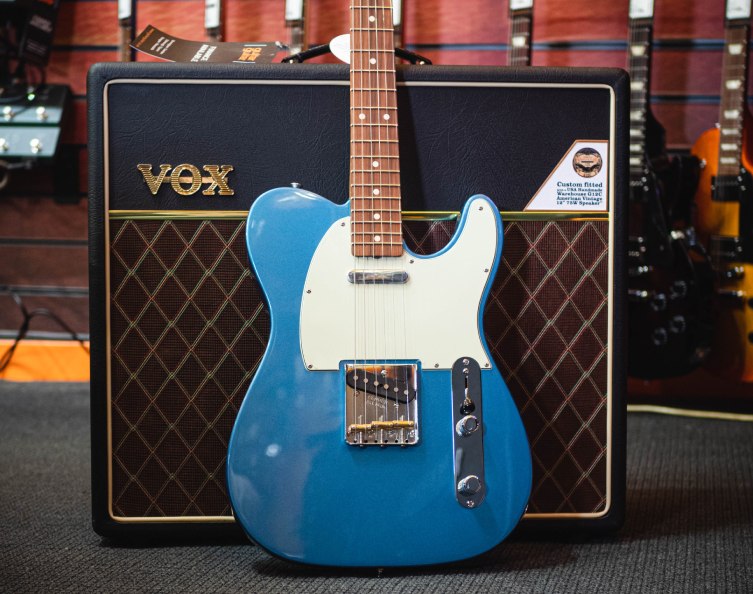
Fender American Pro II Telecaster
For many, this particular instrument is the benchmark of the Fender brand. The American Pro II Telecaster is the ‘standard’ for American-built Fenders.
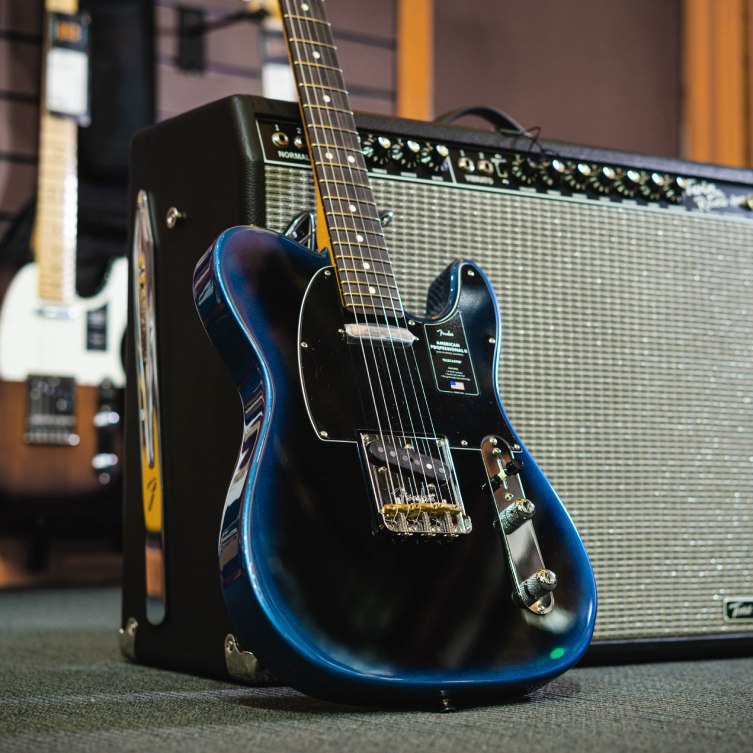
There’s a large number of finishes available, and a choice of maple or rosewood for the fingerboards, but the features don’t stop there:
- Deep C neck shape
- 9.5” radius with narrow tall frets for a feel that’s right in between vintage and modern.
- V-Mod II pickups, specially developed for this range.
- Bridge that strings in two ways: through the body as normal and as a ‘top load’, which changes the feel and sustain.
- Compensated bridge saddles made of brass for authentic tone, modded for better intonation.
- Push-push Tone control for fatter ‘wired in series’ tones.
So, what you can see here is that this model is a good mix of classic and new; of vintage and contemporary. I think Fender have really done their homework here and given players the correct balance of features that improves on what needs improving without redrawing the blueprint. A modern classic? Maybe so. If your budget includes this model, It’s a ‘must-play’.
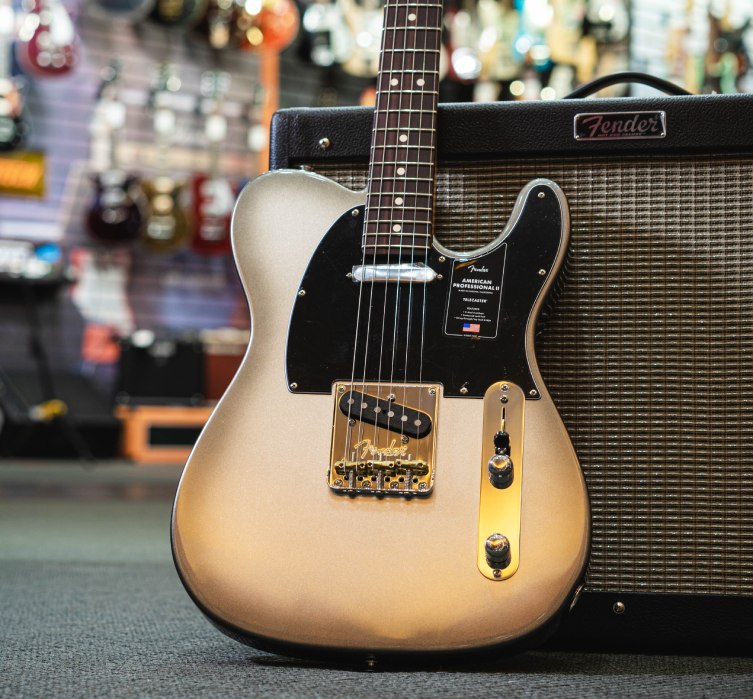
Fender American Vintage II 1951 Telecaster
Similar in theory to the Vintera range but made in the US, the Fender American Vintage Telecaster is the first model price-wise, to use nitrocellulose for the finish. For many vintage-minded players, this is a big deal and thus a significant selling point. ‘Nitro’ ages and wears in ways that typical polyurethane finishes don’t, and it also has a distinctive feel to the touch.
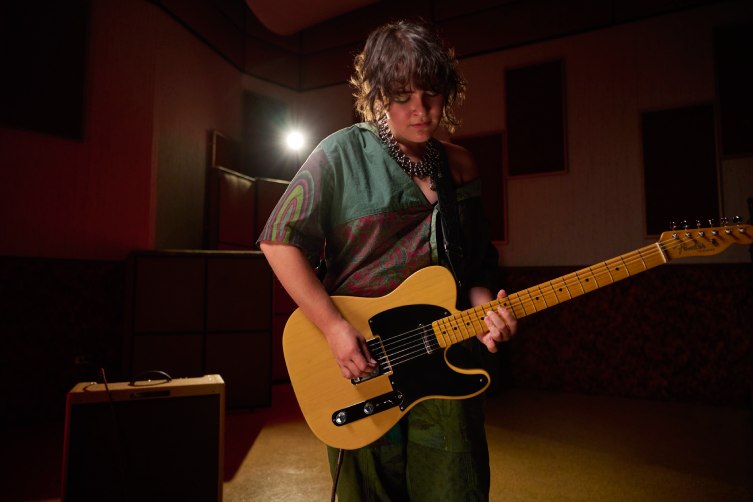
My choice today is for the 1951 Telecaster, presumably referencing the period directly before the ‘Nocaster’ moment when Fender were obliged to rethink the name of their first ever electric guitar.
So, in keeping with what we’ve learned today so far, you’d expect this 50s-themed Telecaster to have certain features, namely: a thick neck, relatively low-output pickups and a bridge with three saddles instead of six. Is this what we’ll find here?
Yup, pretty much! It’s a great recreation of that golden-era Tele, with a resonant Ash body and a nice large ‘U’ shaped neck. This is hardly a guitar for the shredders, but for most other genres out there, this Tele will turn in a stellar performance, along with all of the romance and heritage of a classic Fender Tele.
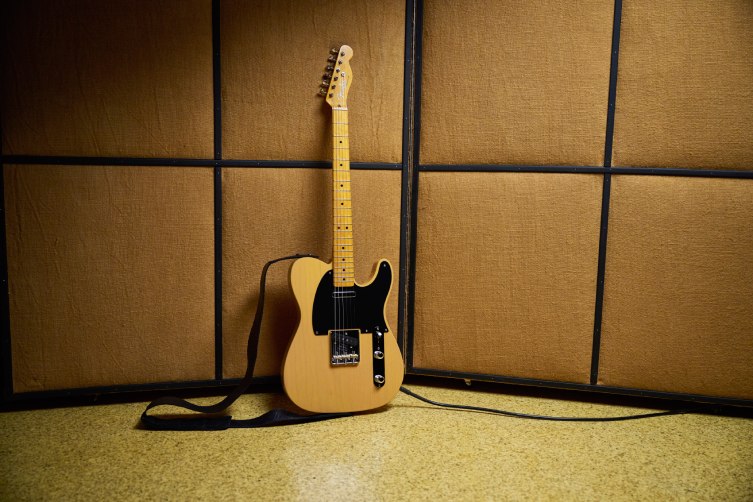
Fender American Ultra Telecaster
Not everybody who appreciates Fender Telecasters want them to be as they were in the fifties, though. Lots of players appreciate the upgrades and refinements that have entered the market in subsequent decades, and for them, the Fender American Ultra Telecaster might just be perfect.

Put simply, this is a tricked-up Tele that’s made for high performance. It’s about as ‘hot-rodded’ as a Tele will get whilst staying within Fender’s parameters, and whilst not being particularly concerned with ‘vintage’ kudos, it’s still very much a regular Tele; it’s just been tweaked a good bit. Let me list some changes that you’ll find on the Ultra Tele…
- Bound top edge of the body and rear contouring.
- Modern ‘D’ neck with rolled fingerboard edges.
- Heel join is ‘tapered’ to give your hand better access to upper frets.
- Compound radius fingerboard of 10-14”: this means that the fingerboard flattens out the higher up it gets, making lead playing particularly effective.
- 22 medium jumbo frets: modern, but not too modern!
- Ultra-Noiseless pickups: they’ll handle all the gain you can throw at ‘em.
- Locking Tuners.
This is a great modern Tele for the player who needs to cover a lot of stylistic ground but still wants that timeless Tele vibe. In reality, that’s a lot of players!
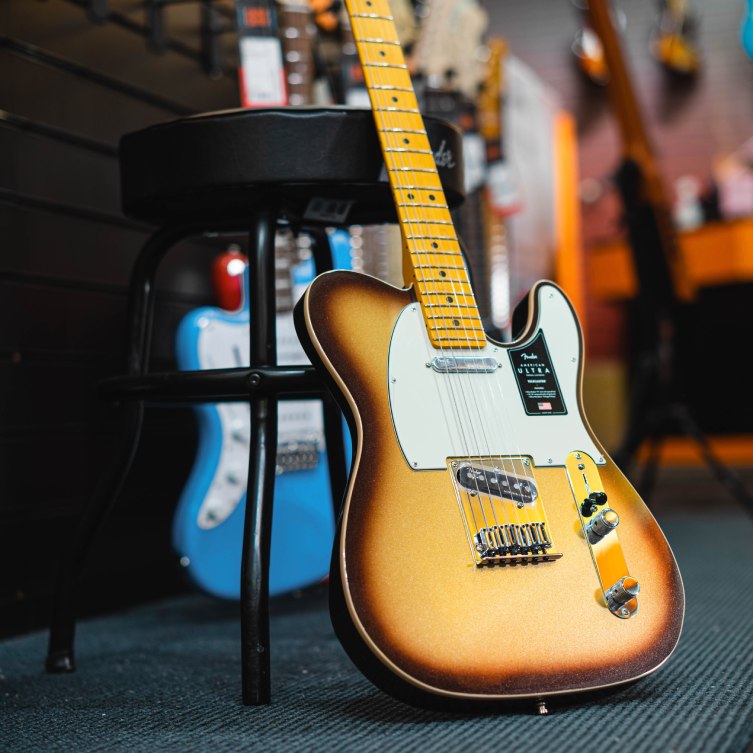
Fender Custom Shop
Lastly, we have the Fender Custom Shop. Now, I’m actually not going to pick out a particular model here, because the offerings from the Fender CS very often chop and change, plus there are all sorts of limited runs being made all the time. This means that advising on any particular guitar is going to be a thankless task since it may well not be available when you read this!
I’m including the Fender Custom Shop here because their guitars are exceptional. It’s that simple. If you want the best, you come here. Either buy something that we spec’d up years ago and finally received, or you put in a custom order with us and be prepared to wait those long years for yours to arrive!
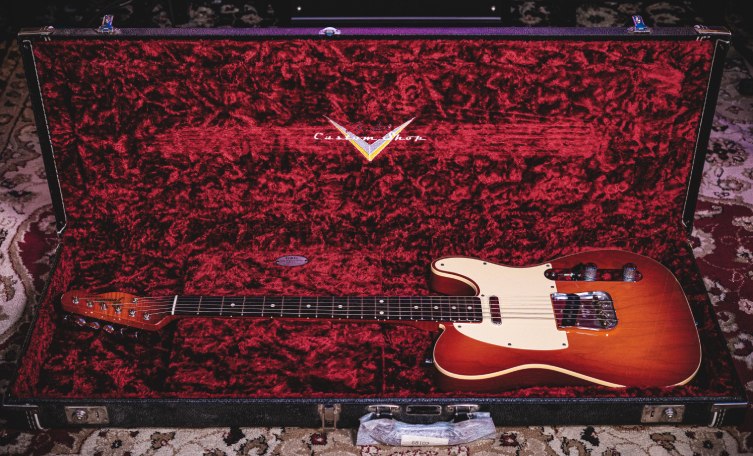
This is the reality of going for the best: the demand is huge and the turnover less so, and that means the waiting list can be long and the price can be high. That said, in all my years at guitarguitar, I’ve never played a less than excellent Fender Custom Shop guitar, so whilst they may be expensive, they are very much worth the asking price. Compared to genuine vintage guitars - a great deal of which do not play or sound as good as a Custom Shop replica - these are a fraction of the price, and much more consistently reliable. Not cheap, but exceptionally good. To put it another way: some vintage guitars are great, and some aren’t. All Fender Custom Shop guitars are great. Simple!
If you’re interested, have a look at what’s currently in stock with us right now, because we carefully spec each one of our Fender CS guitars ourselves. We go for what people seem to love, what we ourselves love and the result is some very special guitars. If it’s in stock, you also don’t need to wait years for a custom order, since we’ve already done all the waiting!
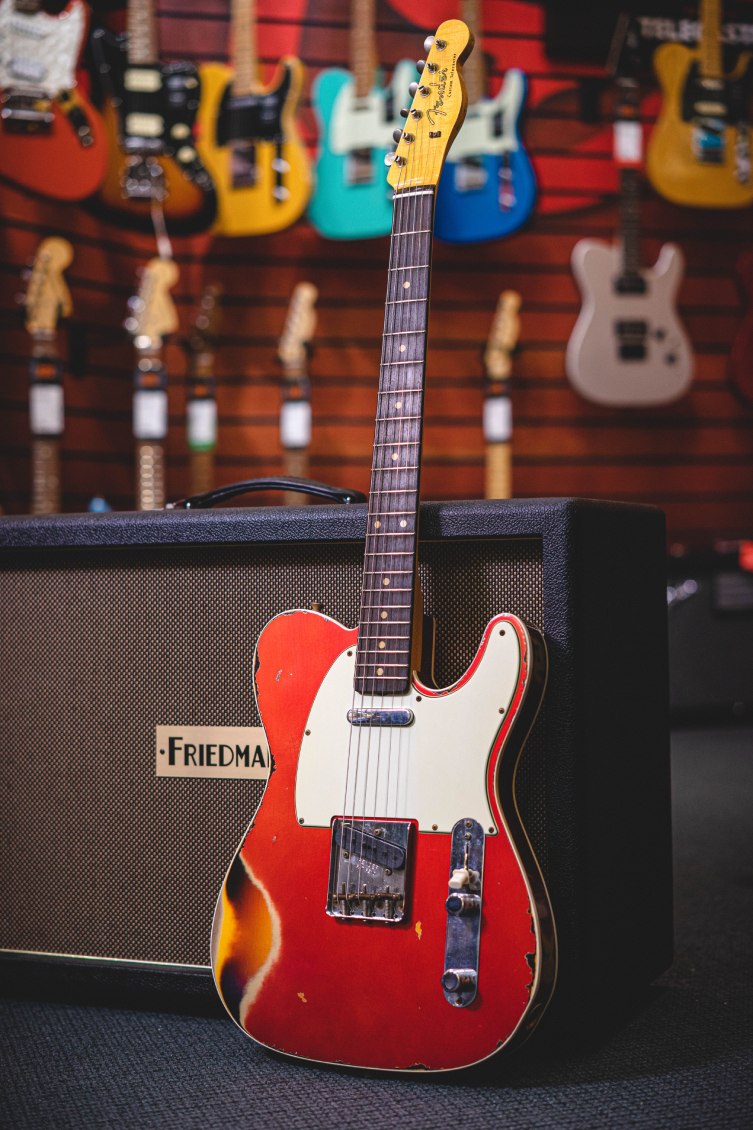
A Telecaster for Everyone
Whilst it’s a fact that a Custom Shop Telecaster is a thing of wonder, I wasn’t making things up when I said that a Squier Classic Vibe is worthy of notice by all guitarists. It’s not in the same league as a Custom Shop Tele of course, but that’s hardly a fair comparison! Each exists for its own market, and I’d never expect somebody looking for a £6k guitar to bother much with one that’s under £400. The point of the comparison is that each is massively effective in its own ‘weight class’, and neither deviates much from that initial 50s formula.
Each of the guitars mentioned today is something I’d be happy to bring on stage. Each will deliver that famous Tele twang to varying degrees, and each (including the Squier, in my opinion) is a real, genuine Fender.
Check them all out: play them, and see which one fits your style. I guarantee you that one will! Best of luck and have fun!
Click to View all of our Fender Telecasters




